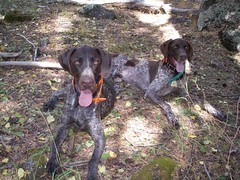Heatstroke in Dogs: Dos and Don'ts
Every year, we see cases of heatstroke in dogs. This is tragic, because heatstroke is preventable.
This weekend, we’ll leave our recent “cool snap” and temperatures will spike into the 105 to 108 degree range. Quick changes in temperature like this increase the risk for heatstroke in dogs. This is especially true for “weekend warriors” who’ve been lounging around inside while their families work and hit the trails or sidewalks when they family has more time to spend with them.
Heatstroke in dogs isn’t limited to pets that are accidentally left in a hot car. Here in the Valley, they’re usually the result of bad timing: exercising for too long, too late in the day, or too late into the summer. Pet owners just don’t realize how dangerous heat can be to their dogs. You wouldn’t believe how many heartbroken pet owners have said the words “but we always hike this trail/run this route/play fetch” as their beloved dog is admitted to the hospital, critically ill.
The good news is that heatstroke is easy to prevent. Here are a few suggestions:
DO:
- Limit exercise to the coolest parts of the day. In the hottest part of the Arizona summer, this may mean not exercising at all some days.
- Restrict activity to the “long shadow hours.” Even if you think “it’s not that hot,” limit activity to the early morning and late evening from mid-April until about Halloween.
- Wet your dog down before exercise. Dogs only have sweat glands between their toes. A quick lap in the pool or drenching with the hose turns Fido’s coat into an evaporative cooler until it’s dry.
- Provide plenty of shade and water for dogs that spend their days outdoors.
- Be aware of the signs of heatstroke in dogs.
DON’T:
- Underestimate the dangers of heat. Dogs can get heatstroke under intense sun even when temperatures are pleasant to us–the low- to mid-80’s!
- Rely on your dog to signal that he’s had too much. Your dog will run, hike, or play with you until he drops. Trust us on this one.
- Take any risks with brachycephalic dogs. Short-faced breeds like bulldogs, boxers, pugs, and Boston terriers are especially sensitive to heat.
- Leave pets in a car. Even in the shade. Even with the windows down. It’s just asking for trouble.
- Make the mistake of thinking “it’s not THAT hot.” It is. Use good judgement and err on the side of caution.
- Expect your dog to show mild signs of illness. Your dog will run or play right through subtle signs of heat exhaustion that would send you inside for a tall glass of water; by the time you know he’s sick, it could be too late to save him.
- Wait to seek veterinary care. Taking a wait-and-see approach usually results in more serious illness, higher medical bills, and–tragically–death. Get to the vet as soon as you’re suspicious that your dog may be suffering from heatstroke.
Want more information? Check out our handout on Heatstroke in Dogs.


